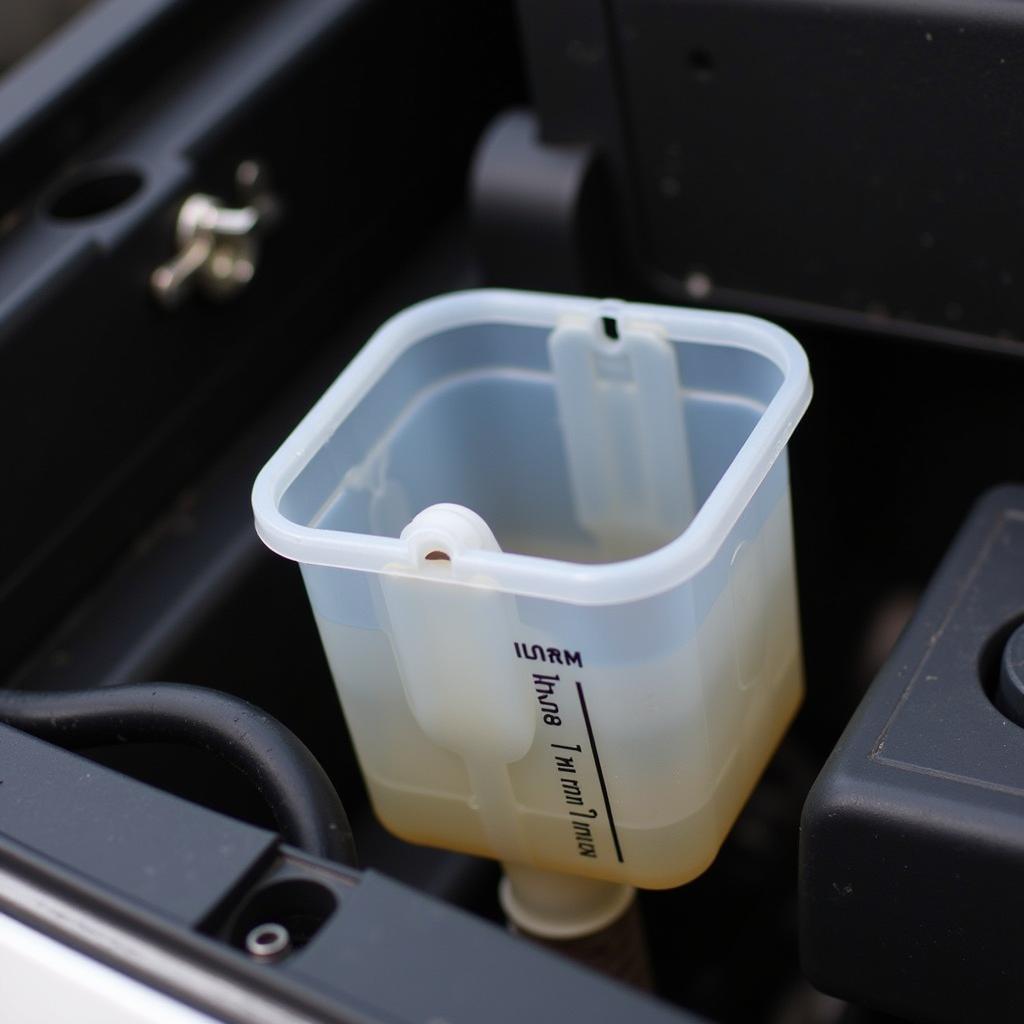The Toyota RAV4 is a popular SUV known for its reliability and safety features. However, like any vehicle, it can experience problems, and one common issue is the brake system warning light coming on. If you’re seeing this light on your RAV4’s dashboard, don’t ignore it. It could signal a serious problem that needs attention.
This article will discuss everything you need to know about the Toyota RAV4 brake system warning light, including what it means, common causes, how to troubleshoot the problem, and potential solutions. We’ll also explore some helpful tips for preventing future issues with your RAV4’s brakes.
Understanding the Brake System Warning Light
The brake system warning light is typically a red exclamation mark inside a circle or a stylized brake caliper. When this light illuminates on your RAV4’s dashboard, it indicates a problem with the vehicle’s braking system. This issue could range from a minor malfunction to a major safety concern.
Common Causes of the RAV4 Brake System Warning Light
Several reasons could cause the brake system warning light to come on in your Toyota RAV4. Here are some of the most common culprits:
1. Low Brake Fluid:
- Explanation: Brake fluid is essential for the hydraulic system that operates your brakes. If the fluid level is low, it can cause the brakes to feel spongy or less responsive.
- Symptoms: The brake pedal may feel soft or mushy, and the warning light may flash when you apply the brakes.
- Solution: Check the brake fluid reservoir and top it up with the correct type of fluid.
2. Worn Brake Pads or Rotors:
- Explanation: Brake pads and rotors wear down over time with use. Worn pads can lead to excessive noise, vibrations, and reduced braking efficiency.
- Symptoms: Squealing or grinding noises when braking, a pulsing sensation in the brake pedal, and a warning light that stays on.
- Solution: Inspect the brake pads and rotors. If they are worn, replace them with new parts.
3. Faulty Brake Sensors:
- Explanation: Brake sensors monitor the wear level of the brake pads and send a signal to the vehicle’s computer. A faulty sensor can trigger the warning light even if the pads are not actually worn.
- Symptoms: The warning light may come on intermittently or stay on constantly, even if there are no other braking issues.
- Solution: Diagnose the brake sensors using a diagnostic tool. If a sensor is faulty, replace it.
4. ABS (Anti-lock Braking System) Malfunction:
- Explanation: The ABS system prevents the wheels from locking up during braking. A fault in this system can cause the warning light to illuminate.
- Symptoms: The ABS system may not function properly, resulting in a lack of traction control or a pulsing sensation in the brake pedal.
- Solution: Diagnose the ABS system using a diagnostic tool. Repair or replace any faulty components.
5. Parking Brake Malfunction:
- Explanation: The parking brake, also known as the emergency brake, plays a crucial role in keeping the vehicle stationary. A malfunctioning parking brake can activate the warning light.
- Symptoms: Difficulty engaging or releasing the parking brake, a feeling of resistance when applying the brake, and a warning light that stays on.
- Solution: Inspect the parking brake system and repair any faulty components.
6. Electrical Issues:
- Explanation: A short circuit or other electrical problems in the brake system’s wiring can trigger the warning light.
- Symptoms: The warning light may come on unexpectedly or intermittently, even if there are no other braking issues.
- Solution: Diagnose the electrical system using a diagnostic tool. Repair any wiring problems.
Troubleshooting the RAV4 Brake System Warning Light
If the brake system warning light illuminates on your RAV4, here are a few steps you can take to troubleshoot the problem:
1. Check the Brake Fluid Level:
- Open the hood and locate the brake fluid reservoir.
- Check the fluid level on the reservoir. The fluid should be within the “Full” and “Low” markings.
- If the level is low, top it up with the correct type of brake fluid.
2. Inspect the Brake Pads and Rotors:
- Jack up the vehicle and secure it with jack stands.
- Remove the wheels to access the brake pads and rotors.
- Visually inspect the brake pads for wear. The minimum pad thickness for most RAV4 models is about 3-4 millimeters.
- Inspect the rotors for grooves, cracks, or excessive wear.
3. Check for Electrical Problems:
- Inspect the brake system wiring for any signs of damage, corrosion, or loose connections.
- Check the brake sensors for proper function and connection.
- Use a diagnostic tool to check for any error codes related to the brake system.
4. Consult a Professional:
If you’re unable to diagnose the problem or feel uncomfortable working on your brakes, it’s always best to consult a qualified mechanic or a Toyota dealership.
How to Fix the RAV4 Brake System Warning Light
Once you’ve identified the cause of the brake system warning light, you can take the appropriate steps to fix the problem.
- For low brake fluid: Top up the reservoir with the correct type of brake fluid.
- For worn brake pads or rotors: Replace them with new parts.
- For faulty brake sensors: Replace the faulty sensor.
- For ABS problems: Diagnose and repair or replace the faulty ABS components.
- For parking brake issues: Repair or replace the faulty parking brake components.
- For electrical problems: Diagnose and repair the electrical system.
Preventing Future Brake System Problems
Here are some tips for preventing future brake system problems on your Toyota RAV4:
- Regular Maintenance: Have your brakes inspected by a professional at least once a year or every 5,000 miles.
- Check Brake Fluid Level: Regularly check the brake fluid level and top it up if necessary.
- Avoid Aggressive Driving: Avoid hard braking and sudden stops.
- Replace Worn Pads and Rotors: Don’t wait until the brake pads are completely worn down before replacing them.
- Inspect for Wear and Damage: Regularly inspect the brake lines, hoses, and calipers for signs of wear or damage.
FAQ
1. What does it mean if the RAV4 brake system warning light comes on when I’m braking?
If the brake system warning light comes on while you’re braking, it could indicate a problem with the hydraulic system, such as low brake fluid or a leak. It’s important to pull over safely and check the brake fluid level.
2. Is it safe to drive with the RAV4 brake system warning light on?
It’s generally not safe to drive with the brake system warning light on. It indicates a problem with the brakes, which could compromise your ability to stop safely.
3. How much does it cost to fix a RAV4 brake system warning light?
The cost of repairing a RAV4 brake system warning light can vary depending on the cause of the problem and the cost of parts and labor in your area.
4. Can I reset the RAV4 brake system warning light myself?
You may be able to reset the warning light yourself by using a diagnostic tool, but this is not always necessary. In many cases, the light will reset automatically once the underlying issue is addressed.
5. What should I do if the RAV4 brake system warning light comes on and stays on?
If the brake system warning light comes on and stays on, it’s essential to stop safely and contact a qualified mechanic or Toyota dealership for diagnosis and repair.
6. Is there a way to check the RAV4 brake system warning light without a diagnostic tool?
While a diagnostic tool can provide a more detailed analysis, you can check the brake fluid level, inspect the brake pads and rotors, and check for any visible signs of damage or wear in the brake system.
7. What if the RAV4 brake system warning light comes on intermittently?
If the brake system warning light comes on intermittently, it’s still essential to investigate the issue. The light may be signaling a developing problem that requires attention.
Conclusion
The Toyota RAV4 brake system warning light is a crucial indicator of potential braking issues. By understanding the common causes, troubleshooting steps, and solutions, you can address any problems promptly and ensure the safety of yourself and others on the road. Remember to always prioritize regular maintenance and be attentive to any unusual sounds or sensations when braking.


